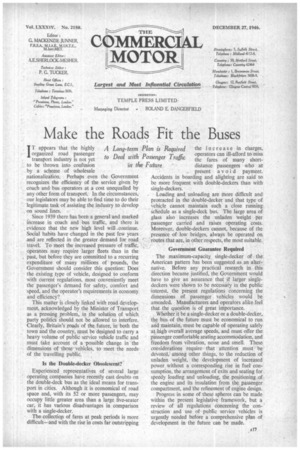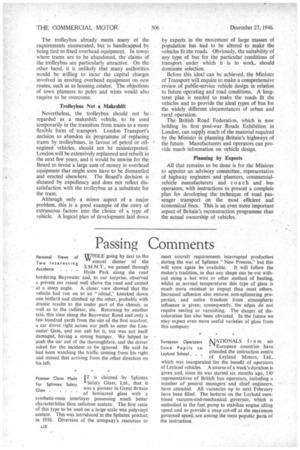Make the Roads Fit the Buses
Page 19

Page 20

If you've noticed an error in this article please click here to report it so we can fix it.
A Long-term Plan is Required to Deal with Passenger Traffic
IT appears that the highly organized road passenger transport industry is not yet to be thrown into confusion by a scheme of wholesale nationalization. Perhaps even the Government recognizes the efficiency of the service given by coach and bus operators at a cost unequalled by any other form of transport. in the circumstances,. our legislators may be able to find time to do their legitimate task of assisting the industry to develop on sound lines. • • Since 1939 there has been a general and marked increase in coach and bus traffic, and there is evidence that the new high level will .continue. Social habits have changed in the past few years and are reflected in the greater demand for road travel. To meet the increased pressure of traffic, operators may require larger fleets than in the past, but before they are committed to a recurring expenditure uf many millions of pounds, the Government should consider this question: Does the existing type of vehicle, designed to conform with current regulations, most conveniently meet the passenger's demand for safety, comfort and speed, and the operator's requirements in economy and efficiency?
This matter is closely linked with road development, acknowledged by the Minister of Transport as a pressing problem, in the solution of which party politics should not be allowed to interfere. Clearly, Britain's roads of the future, in both the town and the country, must be designed to carry a heavy volume of public service vehicle traffic and must take account of a -possible change in the dimensions of -those vehicles, to meet the needs of the travelling public. • Is the Double-decker Obsolescent?'
Experienced representatives of several large operating companies have recently cast doubts on the double-deck bus as the ideal means for transport in cities. Although it is economical of road space and, with its 52 or more passengers, may occupy little greater area than a large five-seater car, it has various disadvantages in comparison with a single-decker.
• The collectiqp of fares at peak periods is more difficult—and with the rise in costs far outstripping the increase in charges, operators can ill-afford to miss the fares of many shortdistance passengers who at present avoid payment. Accidents in boarding and alighting are said to be more frequent with double-deckers than with single-deckers.
Loading and unloading are more difficult and protracted in the double-decker and that type of vehicle cannot maintain such a close running sc. tiedule as a single-deck bus. The large area of glass also increases the unladen weight per passenger carried and raises operating costs. Moreover, double-deckers cannot, because of the presence of low bridges, always be operated on routes that are, in other respects, the most suitable.
Government Guarantee Required The maximum-capacity single-decker of the American pattern has been suggested as. an a hernative. Before any practical research in this direction became justified, the Government would have to give an assurance that if larger singledeckers were shown to be necessary in the public interest, the present regulations concerning the dimensions of passenger vehicles would be amended. Manufacturers and operators alike feel that the question is of great importance.
Whether it be a single-decker or a double-decker, the bus of the future must be economical to run and maintain, must be capable of operating safely at high overall average speeds, and must offer the passenger comfortable seating accommodation, and freedom from vibration, noise and smell. These considerations requirethat attention must• be devoted,. among other things, to the reduction of unladen weight, the development of increased power without a corresponding rise in fuel consumption, the arrangement of exits and seating for speedy loading and unloading, the positioning of the engine and its insulation from the passenger compartment, and The refinement of engine design.
Progress in some of these spheres can be made within the present legislative framework, but a review of all regulations concerning the construction and use of public service vehicles is urgently needed before a comprehensive plan of development in the future can be made. The trolleybus already meets many of the requirements enumerated, but• is handicapped by being tied to fixed overhead equipment. In towns where trams are to be abandoned, the claims of the trolleybus are particularly attractive. On the other hand, it is unlikely that many authorities would be willing to incur the capital charges involved in erecting overhead equipment on new routes, such as to housing estates. The objections of town planners to poles and wires would also require to be overcome.
Trolleybus Not a Makeshift Nevertheless, the trolleybus should not be regarded as a makeshift vehicle, to be used temporarily in the transition from trams to a more flexible form of transport. London Transport's decision to abandon its programme of replacing trams by trolleybuses, in favour of petrol or oilengined vehicles, should not be misinterpreted. London will be extensively replanned and rebuilt in the next few years, and it would be unwise for the Board to invest a large sum of money in overhead equipment that might soon have to be dismantled and erected elsewhere. The Board's decision is dictated by expediency and does not reflect dissatisfaction with the trolleybus as a substitute for the tram.
Although only a minor aspect of a major problem, this is a good example of the entry of extraneous factors into the choice of a type of vehicle. A logical plan of development laid down by experts in the movement Of large masses of population has had to be altered to make the vehicles fit the roads. Obviously, the suitability of any type of bus for the particular conditions of transport under which it is to work, should dominate selection.
Before this ideal can be achieved, the Minister of Transport will require to make a comprehensive review of public-service vehicle design in relation to future operating and road conditions. A longterm plan is needed to make the roads fit the vehicles and to provide the ideal types of bus for the widely different circumstances of urban and rural operation.
The British Road Federation, which is now holding its first post-war Roads Exhibition in London. can supply much of the material required by the Minister in planning Britain's highways of the future. Manufacturers and operators can provide much information on vehicle design.
Planning by Experts All that remains to be done is for the Minister to appoint an advisory committee, representative of highway engineers and planners, commercialvehicle manufacturers and coach and bus operators, with instructions to present a complete plan for developing the technique of road passenger transport on the most efficient and economical lines. This is an even more important aspect of Britain's reconstruction programme than the actual ownership of vehicles.




































































